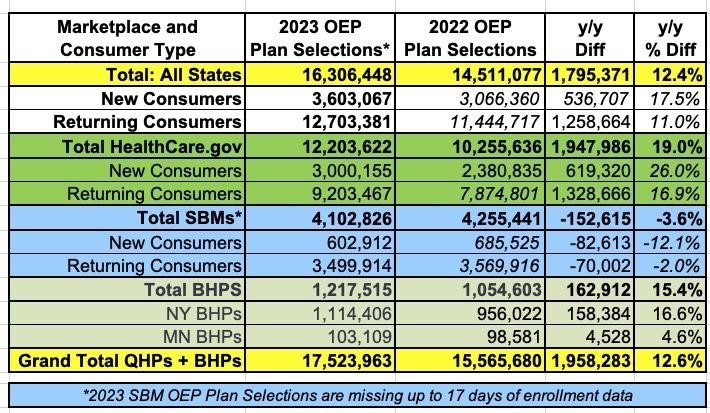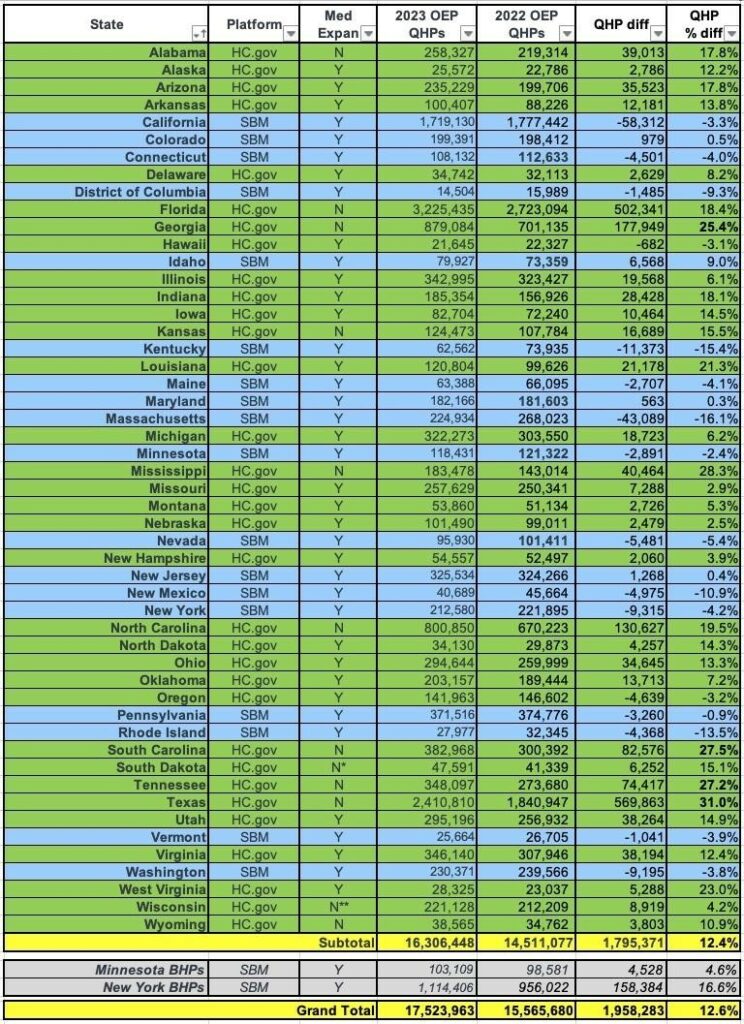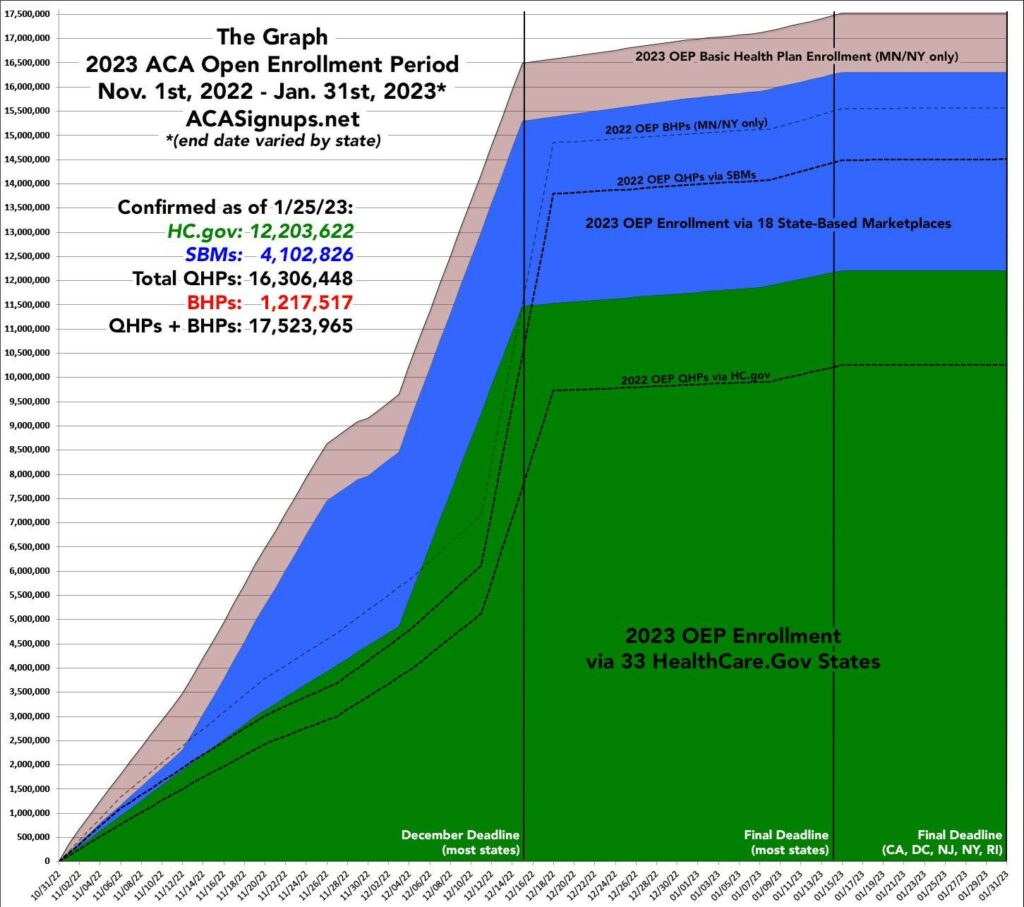The 2023 ACA Open Enrollment Period is the best ever. The prime reason being the expansion of enhanced premium subsidies, first introduced in 2021 via the American Rescue Plan. ACA premiums became less costly for those who were already qualified. The lower pricing of ACA plans resulted in the expansion of eligibility to millions who were not previously eligible. The ARP ACA expansion will continue for at least another 3 years under the Inflation Reduction Act. Then who knows? Maybe by then the nation will push through Single Payer. Another update from Charles Gaba’s Blog, ACA Signups on the ACA Open Enrollment period. BOOM: 2023 Open Enrollment breaks 17.5M w/BHPs included. Up 13% y/y w/6 days left to #Get Covered in some states! ACA
Topics:
run75441 considers the following as important: 2023 ACA Open Enrollment, ACA Signups, Charles Gaba, Healthcare, Hot Topics, law, politics
This could be interesting, too:
Robert Skidelsky writes Lord Skidelsky to ask His Majesty’s Government what is their policy with regard to the Ukraine war following the new policy of the government of the United States of America.
NewDealdemocrat writes JOLTS revisions from Yesterday’s Report
Joel Eissenberg writes No Invading Allies Act
Ken Melvin writes A Developed Taste
The 2023 ACA Open Enrollment Period is the best ever. The prime reason being the expansion of enhanced premium subsidies, first introduced in 2021 via the American Rescue Plan. ACA premiums became less costly for those who were already qualified. The lower pricing of ACA plans resulted in the expansion of eligibility to millions who were not previously eligible. The ARP ACA expansion will continue for at least another 3 years under the Inflation Reduction Act.
Then who knows? Maybe by then the nation will push through Single Payer.
Another update from Charles Gaba’s Blog, ACA Signups on the ACA Open Enrollment period.
BOOM: 2023 Open Enrollment breaks 17.5M w/BHPs included. Up 13% y/y w/6 days left to #Get Covered in some states! ACA Signups, Charles Gaba’s Blog
Biden-Harris Administration Announces Record-Breaking 16.3 Million People Signed Up for Health Care Coverage in ACA Marketplaces During 2022-2023 Open Enrollment Season
Nearly 50% increase in HealthCare.gov signups since President Biden took office, and 3.6 million people signed up for health care coverage on the Marketplaces for the first time this year.
Today, the Biden-Harris Administration announced that a record-breaking more than 16.3 million people have selected an Affordable Care Act (ACA) Marketplace health plan nationwide during the 2023 Marketplace Open Enrollment Period (OEP) that ran from November 1, 2022- January 15, 2023 for most Marketplaces. President Biden promised to strengthen and build on the Affordable Care Act, and this year, the 10th year of ACA Open Enrollment, more Americans signed up for high-quality, affordable health insurance through the ACA Marketplaces than ever before. Since President Biden took office, the number of people who have signed up for an affordable health care plan through HealthCare.gov has increased by nearly 50%. Because of the President’s plan, millions of working families saved an average of $800 on their health insurance premiums last year.
Note: It’s buried at the bottom as a footnote (as usual), but in addition, over 1.14 million New Yorkers have enrolled in Basic Health Plan policies. While the footnote doesn’t include Minnesota’s BHP enrollment, the MN DHS website lists January enrollment as 103K.
Combined, that’s over 17.5 million Americans who’ve signed up for either a Qualified Health Plan (QHP) or Basic Health Plan (BHP) nationally so far…and again, that’s only through either January 15th (or Jan. 14th in some states). Open Enrollment continues through January 31st in California, DC, New Jersey, New York and Rhode Island, so the final tally (w/BHPs) could end up being as high as 17.6 million.
Total plan selections include 3.6 million people (22% of total) who are new to the Marketplaces for 2023, and 12.7 million people (78% of total) who had active 2022 coverage and made a plan selection for 2023 coverage or were automatically re-enrolled. Over 1.8 million more people have signed up for health insurance, or a 13% increase, from this time last year. The 3.6 million plan selections from people who are new to the Marketplaces represent a 21% increase in new- to-Marketplace plan selections over last year.
HHS Secretary Xavier Becerra:
“Unprecedented investments lead to unprecedented results. “Thanks to President Biden’s leadership, more than 16 million Americans have health insurance through the Affordable Care Act Marketplaces – an all-time high. The Biden-Harris Administration has made lowering health care costs and expanding access to health insurance a top priority – and these record-breaking numbers show we are delivering results for the American people. We will keep doing everything we can to ensure more people have the peace of mind that comes with high-quality, affordable health care.”
The 13% year/year increase refers to QHP enrollment only . . . but BHP enrollment in NY & MN are around 13% higher than last year as well, so there you go. CMS Administrator Chiquita Brooks-LaSure:
“President Biden promised to build on the success of the Affordable Care Act and make it easier for people to enroll and find affordable, quality coverage – and that promise has been kept. On the tenth anniversary of the ACA Marketplaces, the numbers speak for themselves: more people signed up for plans this year than ever before, and the uninsured rate is at an all-time low.”
The Biden-Harris Administration has made expanding access to health insurance and lowering health care costs for America’s families a top priority, and under their leadership, the national uninsured rate reached an all-time low earlier this year, and the 2023 Marketplace Open Enrollment Period saw the highest number of plan selections of any year since the launch of the ACA Marketplaces ten years ago.
This year, individuals benefited from a highly competitive Marketplace. Ninety-two percent of HealthCare.gov enrollees had access to options from three or more insurance companies when they shopped for plans. Also, new standardized plan options were available in 2023 through HealthCare.gov, which helped consumers compare and select plans. Thanks to the Inflation Reduction Act, more people this year continued to qualify for help purchasing quality health coverage with expanded financial assistance, resulting in four out of five people returning to HealthCare.gov being able to find a plan for $10 or less after tax credits.
Today’s snapshot represents activity through January 15, 2023 for the 33 Marketplaces using HealthCare.gov and through January 14 or 15, 2023 for the 18 State-based Marketplaces (SBMs) in 17 states and the District of Columbia that are using their own eligibility and enrollment platforms.
Marketplace Enrollment Snapshot Overview:
Marketplace and Consumer Type / Cumulative 2023 OEP Plan Selections
All Marketplaces Total / 16,306,448
- New Consumers / 3,603,067
- Returning Consumers* / 12,703,381
HealthCare.gov Marketplaces Totals / 12,203,622
- New Consumers / 3,000,155
- Returning Consumers / 9,203,467
Total SBMs** / 4,102,826
- New Consumers / 602,912
- Returning Consumers / 3,499,914
While the 2023 Open Enrollment Period has closed for the 33 Marketplaces using HealthCare.gov, State-Based Marketplace deadlines vary and enrollment continues in several states. State-specific deadlines and other information are available in the State-based Marketplace Open Enrollment Fact Sheet.
Individuals who meet certain conditions may be eligible for a Special Enrollment Period (SEP) and can determine if they qualify by visiting HealthCare.gov, or CuidadoDeSalud.gov, or by calling 1-800-318-2596.
* The returning consumers metric in this report only includes both consumers who have returned to their respective Marketplace through the reporting date and selected a plan for 2023 coverage, and consumers who have been automatically re-enrolled in their 2022 plan or a suggested alternate plan for 2023 coverage.
** In addition to reported plan selections, New York and Minnesota have a Basic Health Program (BHP), which generally provides coverage to consumers with household incomes up to 200 percent of the FPL who are not eligible for Medicaid or CHIP and otherwise would be eligible for a QHP. From November 1 – January 14, 2023, New York had a total of 1,114,406 individuals enroll in a BHP. Minnesota’s BHP data was not available at the time of this report.
Again: 16,306,448 QHPs + 1,114,406 NY BHPs + 103,109 MN BHPs = 17,523,963 total…or nearly 13% higher than last year.
Here’s the 2023 vs. 2022 comparison, but it’s important to keep in mind that there’s still up to 17 days of enrollment data missing from some of the 18 state-based exchanges:
As a side note, this is pretty damn close to what I said a few weeks ago:
Again, there’s still time left for people to sign up in every state except Idaho, which ended Open Enrollment on December 15th. Assuming the ~13% y/y increase holds through the final end of OEP in every state on January 31st, that would put total QHP + BHP enrollment at nearly 17.6 million nationally when the dust settles, or roughly half a million higher than today’s tallies.
Again, Open Enrollment is still going on for another 6 days in CA, DC, NJ, NY & RI, so it might end up hitting that 17.6M grand total after all (or at least come very, very close to it).
Here’s the state-by-state breakout. I’ve added rows for the BHP programs in MN & NY at the bottom:
Here’s the state-level data grouped by federal exchange vs. state-based exchange, as well as Medicaid expansion/non-expansion. Keep in mind that South Dakota’s expansion hasn’t gone into effect yet, and Wisconsin has an alternate partial expansion up to the federal poverty line. Also keep in mind, again, that many of the SBM states still have up to 17 days of data missing:
As you can see, while SBM states are ~3.6% behind last year (again, with 2023 enrollment data missing for some of them), they’re actually slightly ahead of last year when BHP enrollees are included. FFM states, meanwhile, are up 19% over last year (that data is final for both years).
Medicaid expansion states are up around 2% y/y overall, while non-expansion states are up an impressive 22.7%.
When you break the FFM states out between expansion/non-expansion status, the former are up 9.9% overall, while the latter are, again, up 22.7%
Other points of interest:
- Texas has seen the most impressive y/y enrollment improvement, up a whopping 31% since last year. Much of this is likey due, again, to their state-mandated Premium Alignment law (aka Silver Loading) which was first implemented this year.
- Mississippi, South Carolina, Tennessee and Georgia–all southern, none of which have expanded Medicaid either–are all up over 25% y/y.
- At the opposite end, Massachusetts, Kentucky, Rhode Island and New Mexico are all down by double digits (10 – 16%), although again, there’s enrollment data missing for two of these (MA & RI).
What? Biden Strengthens Medicare with Policies Simplifying Enrollment and Expanding Access? – Angry Bear, taken from ACA Signups, Charles Gaba




